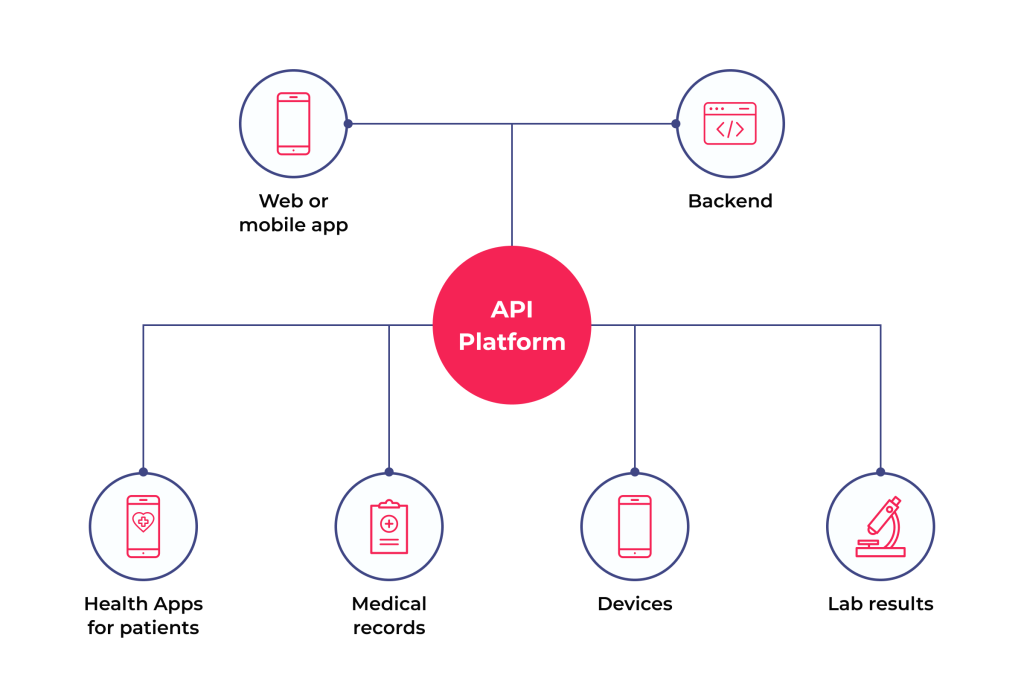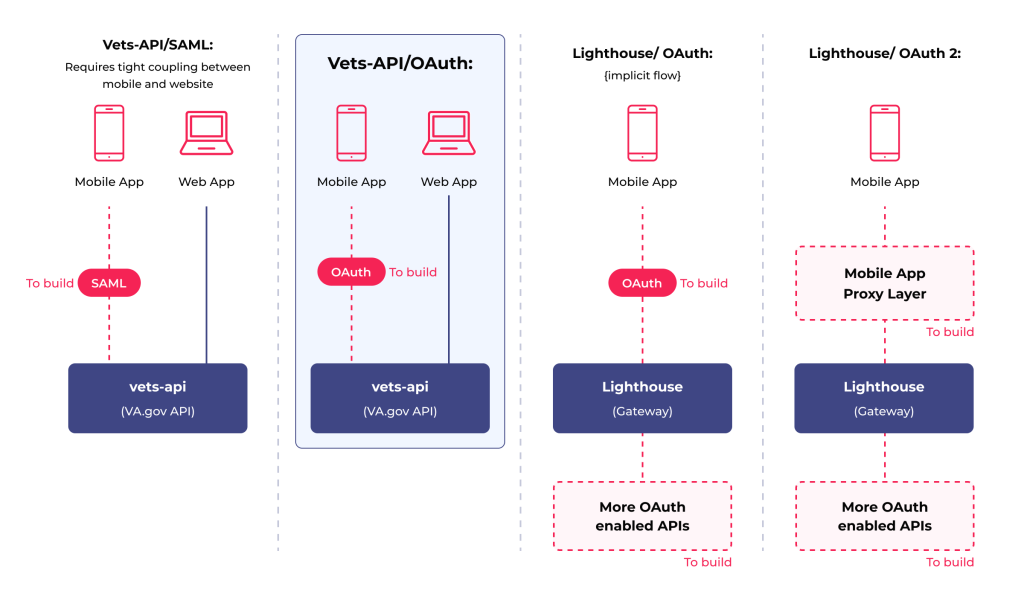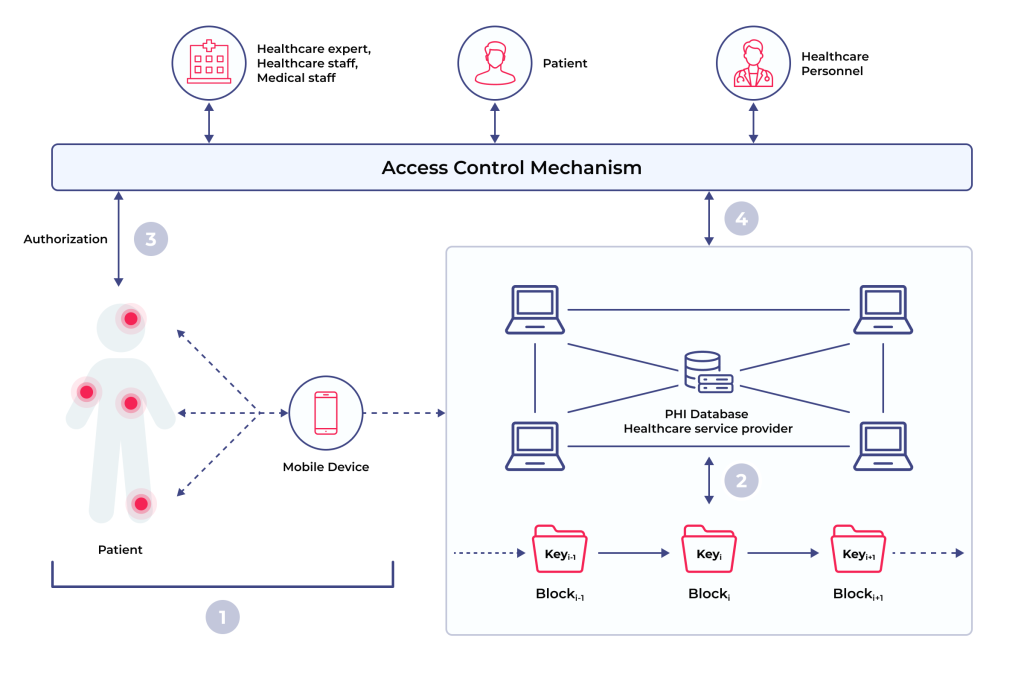Adopting electronic health records (EHRs) marks a significant milestone in the journey towards digitization in healthcare. The massive EHR adoption among office-based physicians started in the 2000s and has reached 86% by 2020. However, the true potential of EHRs is unleashed when these systems are not just static repositories of patient data but dynamic resources that can communicate seamlessly with various healthcare applications.

That is where EHR application programming interfaces (APIs) enter the scene as the bridge between EHR systems and the plethora of health apps, services, and administrative tools. EHR APIs have immense potential: 90% of stakeholders in healthcare facilities believe that they are critical for business strategy, but only 24% employ them.

So, while other healthcare facilities are considering whether EHR API adoption is worth it, start the process now. The first step is diving into EHR API features, benefits, integration steps, and security considerations, which we cover in this article.
Table of Contents
“In the ever-evolving field of healthcare technology, staying ahead is crucial. Our expertise in custom EHR API solutions has revolutionized our clients’ operational efficiency and significantly enhanced patient care. Partnering with us means pushing the boundaries of what is possible in health tech, impacting the lives of patients and the entire healthcare domain.”
Romaniya Mykyta
Head of Product Management, SPSoft
“At the heart of healthcare innovation is the drive to offer better patient experiences, and our focus on EHR API integration is a testament to this commitment. Our approach to EHR API development implies seamlessly blending technology with patient-centric care to elevate your service delivery, allowing you to connect with and improve your patients’ lives in ways we never thought possible.”
Mike Lazor
CEO, SPSoft
EHR API Must-Have Features
Choosing the proper EHR API is crucial for healthcare providers aiming to optimize their clinical workflows and patient management. Here are the essential features to look for:
- Standard compliance — for instance, a top-tier Epic EHR API documentation should comply with industry standards such as HL7, FHIR, and the CDA to communicate effectively with other systems, which is key to interoperability.
- Interoperability — the EHR integration API must facilitate EHR interoperability, including seamless data exchange with healthcare apps and third-party systems to create a cohesive healthcare technical system.
- Security and privacy — given the sensitive nature of health data, a robust EHR API must include strong security features to protect patient information, like HIPAA and GDPR compliance, data encryption, and regular security updates.
- Robust documentation and developer support — comprehensive documentation reduces the learning curve and integration time, while developer support can help resolve issues that arise during development.

- Scalability — EHR APIs should be able to handle increasing workloads as the healthcare provider grows.
- Customization and flexibility — an API should enable a provider to tailor the software to their specific requirements, such as custom data fields, specific workflows, or integrations with proprietary systems.
- Usability and ease of integration — the EHR API should have a straightforward implementation process that requires no extensive downtime or learning curves for staff.
- Real-time data access — an EHR API should offer real-time or near real-time patient data updates to ensure that healthcare providers have the most up-to-date information.
- Patient access — with patient-centered care becoming more prominent, the Epic EHR API documentation must provide mechanisms for patient access to their health records.
By prioritizing these features, you can select an EHR API that fits your organization’s current needs and scales with its growth and future advancements in healthcare technology.
Have specific questions or need expert advice on EHR API integration? Сontact us — our team is ready to provide personalized solutions for your unique needs!
The Immense Benefits of Using API in Healthcare
Integrating APIs in healthcare is a transformational move towards more connected, efficient, and patient-centered services. Here is a deep dive into the manifold pros they offer in the domain.
1. Operational Efficiency
APIs can improve the operational efficiency of your organization by enhancing interoperability, streamlining workflows, and increasing cost efficiency.
Enhanced Interoperability
The most significant advantage is the seamless exchange of information between disparate healthcare systems. APIs act as translators, allowing different software apps to understand each other, breaking down data silos, and ensuring that health information is accessible if needed.
Streamlined Workflows
EHR integration API automates many routine data transactions that can slow down healthcare operations. For instance, lab results can be automatically pushed to an EHR, and appointment schedules can be synchronized across platforms. That allows staff to focus on patient care rather than administrative tasks.
Cost Efficiency
APIs automate data exchange and streamline communication, which can significantly reduce administrative overhead. Besides, the automation APIs introduced can lower the costs related to paper-based systems and minimize costly errors due to miscommunication or incomplete data.

2. Innovation and Technological Advancement
Innovation and Development
Open APIs create an environment primed for innovation. In particular, developers can build new apps and tools that directly interface with EHRs and other health systems. It fosters a creative ecosystem that continually pushes the boundaries of what is possible in healthcare technology.
Scalability
As healthcare facilities grow, EHR APIs enable them to scale their IT infrastructure without increasing complexity or cost. With Epic EHR API documentation, your tech team can add new applications and services to the system through APIs without requiring major system overhauls.
3. Clinical Outcomes
Improved Patient Outcomes
With an Epic EHR API enabling real-time data exchange, clinicians can access patient records, lab results, and other critical health data. This accessibility allows for timely, informed decisions, leading to more accurate diagnoses, personalized treatment plans, and better patient outcomes.
Patient Engagement and Empowerment
APIs empower patients by giving them access to their medical data, often through patient portals or mobile apps. That can encourage more active involvement in their health and wellness, leading to better adherence to treatment plans and healthier lifestyle choices.
4. Other Benefits
Data Analytics and Insights
APIs facilitate the aggregation and analysis of large health data volumes. That can result in actionable insights into population health trends, the effectiveness of treatment protocols, and operational efficiencies, among other benefits.
Compliance and Standardization
Using APIs that adhere to healthcare standards allows providers to ensure they remain compliant with regulatory requirements, both local and international.
Want to delve deeper into how EHRs can transform your practice? Read our article on EHR application for a better understanding of its benefits and use cases!
EHR API Integration: A Step-By-Step Guide
Effective integration of EHR APIs is a complex process that demands careful planning and execution. To achieve a seamless and productive EHR API integration, healthcare organizations can follow these three stages.
Stage 1. Developing the Project
The first stage consists of preparation steps on your way to API integration. Here they are:
- Define objectives and requirements. Clearly outline what you want to achieve with the API integration. Determine the specific workflows that need to be addressed, the data that should be exchanged, and the stakeholders who will use or be affected by the API.
- Assess and select the right API. Evaluate potential Epic EHR API documentation for compatibility with your EHR system, ensuring they meet the healthcare standards for interoperability, security, and data exchange. Consider the features, scalability, support, and costs involved.
- Develop a project plan. Create a comprehensive project plan that includes timelines, milestones, resource allocation, and risk management strategies.
- Ensure regulatory compliance. Understand and adhere to all relevant healthcare regulations to protect patient privacy and ensure data security.

Stage 2. Testing and Go-Live Preparation
The second stage involves EHR integration API and guaranteeing it performs as expected. Here are the processes covered:
- Prepare the environment. Ensure that the current EHR system and IT infrastructure are ready for integration. That may include hardware upgrades, software updates, or other system modifications.
- Collaborate with vendors. Work closely with the EHR API vendors to get insights and assistance throughout the integration process, from project planning to execution and troubleshooting support.
- Pilot testing. Before full-scale implementation, conduct a pilot test with a limited scope to evaluate the API’s performance and identify any issues in a controlled environment. Use real-world scenarios to see how the integration affects day-to-day operations.
- Security testing. Conduct thorough security testing to identify and address any vulnerabilities the new integration introduces. That includes penetration testing, vulnerability scanning, and security audits.
- Data migration. If the integration involves transferring existing data into a new system, ensure that data migration is handled carefully to maintain data integrity and minimize disruption to operations.
- Train staff. Develop a training program for the healthcare providers, administrators, and IT staff using the EHR API. Ensure they understand how to use the new tools and processes effectively.
Stage 3. Go-Live
The final stage of API integration consists of launching the integration and monitoring its performance closely:
- Integration execution. Switch from the testing or staging environment to the live production environment to make EHR API integration live. Make sure that disruptions to daily operations are minimized.
- Monitor and evaluate. After implementation, continuously monitor the system’s performance. Assess whether the integration meets the defined objectives and identify any areas for improvement.
- Provide ongoing support and maintenance. Provide continuous support for users and have a plan for regular maintenance and updates. Respond to feedback and adjust as needed to ensure effective and secure integration.
These steps can ensure healthcare organizations have a robust and efficient EHR integration API for enhanced interoperability, improved patient care, and optimized clinical workflows.
Eager to unlock the full potential of your healthcare system with advanced EHR interoperability? Explore how integrated data exchange is revolutionizing patient care!
Use Case: API Integration for Veteran Health Management
In 2016, the Department of Veterans Affairs (VA) launched the Lighthouse program to provide a modern API framework that allows private sector organizations to develop services for veterans and improve their healthcare experience.

Before API implementation, veterans often had difficulty keeping track of appointments, medication refills, and communicating with their healthcare team.
Accessing their health records meant calling the VA or visiting in person, which was time-consuming and sometimes frustrating. Sharing information between their providers required faxes or manual data entry, leading to delays and occasional errors.
After Lighthouse API implementation, the experience has significantly improved for veterans in several ways:
- Access to health records via a mobile app that integrates with the VA’s APIs
- Appointment scheduling through the app
- Medication tracking and refills
- Interoperability with community care providers
- Remote monitoring for certain conditions
This integration across the VA’s systems demonstrates the power of EHR APIs in healthcare. For many veterans, this has led to a better-organized, more accessible, and more personalized healthcare experience. The mentioned case highlights how EHR APIs can bridge the gap between healthcare providers and patients, streamlining processes that were once cumbersome and prone to error. It has been a real-world testament to the transformative potential of APIs.
Security Considerations for EHR API Integration
When integrating an EHR API, security is paramount. Protected health information (PHI) is susceptible, and any breach could have severe consequences for patients and providers. So, here are crucial security considerations to address during the integration.
1. Data Encryption
Data should be encrypted both in transit and at rest. Use strong encryption standards such as Advanced Encryption Standard (AES) and secure transmission protocols like Transport Layer Security (TLS) to protect data as it moves between systems. Beyond AES and TLS, consider incorporating end-to-end encryption to safeguard data throughout its entire lifecycle. Use encryption key management systems to ensure the secure handling of keys.
2. Authentication and Authorization
Implement strong user authentication protocols to ensure only authorized users can access the EHR integration API. That often includes using OAuth2 for secure delegated access, ensuring users are who they say they are and have appropriate permissions. In addition to OAuth2, consider implementing multi-factor authentication (MFA) and continuous authentication processes where user credentials are periodically verified during a session.
3. Regular Security Audits
Conduct regular security audits to identify and address vulnerabilities by reviewing the Epic EHR API documentation, the associated EHR system, and any other connected systems. These audits should also include penetration testing and ethical hacking to simulate potential cyberattacks and identify weaknesses.
4. Access Control
Use role-based access control (RBAC) to ensure users can only access the data necessary for their role. That minimizes the risk of inappropriate access to sensitive data. Integrate advanced RBAC with attribute-based access control (ABAC) for more granular control, considering user context and environment in access decisions.

5. Compliance with Regulations
Ensure the Epic EHR API documentation complies with all relevant health information privacy regulations. That includes meeting the requirements for the handling, storing, and transmitting of PHI. Regularly update compliance protocols to keep pace with evolving regulations. Also, consider adopting international standards such as ISO 27001 for a broader security framework.
6. Monitoring and Logging
Implement logging and monitoring mechanisms to track EHR API usage and detect abnormal patterns that may indicate a security threat. Ensure that logs are stored securely and are analyzed regularly. Lastly, use advanced anomaly detection systems and AI-driven monitoring solutions to identify and alert suspicious activities more effectively.
7. Secure Development Practices
Follow secure coding practices during the development phase of the API integration to prevent common vulnerabilities such as SQL injection, cross-site scripting (XSS), and others. Adopt a DevSecOps approach, integrating security at every stage of the development lifecycle and ensuring continuous security assessment.
8. Incident Response Plan
Have a clear incident response plan in case of a data breach. That should include containment, eradication, recovery steps, and notification procedures for affected individuals. Regularly update and test the incident response plan with drills and simulations to ensure readiness for various breach scenarios.
9. Third-Party Risk Assessment
Conduct a thorough risk assessment to ensure they meet your security standards using third-party components or services as part of the EHR integration API. Continuously monitor and evaluate the security postures of third-party vendors and establish clear contractual obligations regarding data security.
10. API Gateway
Use an API gateway to manage access to your EHR API. Gateways can provide an additional layer of security, including rate limiting, IP filtering, and more sophisticated access controls. Consider integrating advanced threat protection solutions within the API gateway for enhanced security against complex threats.
11. Secure Configuration
Ensure that all Epic EHR API integration systems are securely configured. Change default passwords, turn off unnecessary services, and harden systems against attacks. Regularly update and patch systems to address vulnerabilities. Additionally, implement security configuration management tools to automate secure system configuration maintenance.
How Much Will It Cost to Integrate EHR API?
The cost to integrate EHR APIs can vary widely depending on several factors. Here are some of the key cost factors to be aware of when planning API integration:
- API licensing fees — some EHR vendors charge a fee for accessing their APIs, which could be a one-time charge or an ongoing subscription model.
- Custom development — if the out-of-the-box API does not meet all the requirements, custom development may be necessary. Its cost will depend on the complexity of the customizations and the engineering team’s rate or project fee.
- Third-party services — the integration might require additional third-party services for identity verification, secure data storage, or analytics. Each of them will add to the overall cost.
- Data migration — if integrating a new EHR API requires transferring existing data, there will be costs associated with data migration services. They can be substantial depending on the volume and complexity of the data.

- Staff training — the cost will vary based on the Epic EHR API documentation available, the extent of the training required, and the number of staff to be trained.
- Maintenance and support — ongoing maintenance, updates, and support services are usually needed and can be a significant part of the total cost of ownership.
- Infrastructure — if the integration requires additional hardware or an upgrade to existing infrastructure, this will also factor into the costs.
- Downtime — EHR integration API can lead to system downtime, which has indirect costs associated with lost productivity and potential disruption to patient services.
Given these variables, the cost to integrate EHR API integration can range from a few thousand dollars (for a simple integration using standard features) to hundreds of thousands, or even millions (for a complex, large-scale integration that requires extensive customization and robust data migration).
Curious about the behind-the-scenes of EHR software development? Discover the technical nuances and innovative approaches in our extensive article!
Final Thoughts on EHR API Integration
Integrating APIs into EHR systems marks a significant leap forward for the healthcare industry, promising to unlock efficiencies and improve the quality of care. While the benefits are substantial, the path to integration is complex and requires meticulous planning and execution.
However, getting a partner for this process can help navigate the process with more clarity. SPsoft has seasoned professionals in EHR API integration, equipped with the expertise and experience necessary to guide you through every step of the process. Our tailored approach delivers a solution that is technically robust and thoughtfully crafted to meet your specific goals.
Ready to take the next step in advancing your healthcare services? Contact us to discuss how our state-of-the-art EHR solutions can be integrated into your practice!
FAQ
What is the EHR API?
An EHR (Electronic Health Record) API (Application Programming Interface) is a set of protocols and tools that allows different healthcare software systems to communicate. It enables the seamless exchange and integration of electronic health data between EHR systems and other healthcare applications, like lab systems, billing software, and patient portals. EHR APIs are crucial in achieving interoperability within the healthcare ecosystem, facilitating the efficient and secure transfer of patient information.
What are the main advantages of the EHR API?
The main advantages of EHR API include:
– enhanced interoperability
– streamlined workflows
– improved patient outcomes
– innovation and development
– patient engagement
– cost efficiency
– data analytics and insights
– scalability
– compliance and standardization
Who offers the best EHR integration consulting services for healthcare interoperability?
Achieving seamless healthcare interoperability often requires specialized expertise to navigate complex EHR systems, data standards, and integration challenges. Consulting services in this area help healthcare organizations connect disparate systems, optimize data flow, and meet regulatory requirements. Here are five top companies offering EHR integration consulting:
– SPsoft. SPsoft provides specialized consulting and development services focused on cross-platform healthcare data interoperability. We excel at connecting systems like Epic, Cerner, and custom tools using standards like HL7 and FHIR. As an official Epic Vendor Services partner, we offer expert Epic FHIR/HL7 integrations. Our services include building SMART-on-FHIR apps, creating real-time data exchange solutions, converting legacy data to FHIR, data aggregation and standardization.
– Redox. While known for their API platform, Redox also offers significant integration strategy and consulting services. They help healthcare organizations and technology vendors plan and execute complex integrations with various EHRs. Their deep expertise in navigating different EHR vendor requirements (Epic, Cerner, Athenahealth, etc.) and various data standards (HL7v2, FHIR, CDA, X12) makes their consulting valuable for achieving broad interoperability.
– KMS Technology. KMS Technology provides healthcare software development and consulting services with a focus on interoperability and compliance. They assist clients in designing integration strategies, implementing solutions using HL7 and FHIR standards, and ensuring seamless data exchange between EHRs, patient portals, and third-party applications. Their consulting often covers architecture design, security best practices, and navigating the complexities of connecting healthcare systems.
– Itransition. Itransition offers healthcare IT consulting services that heavily feature EHR integration and interoperability strategy. They help organizations plan and implement connections between diverse clinical and administrative systems, ensuring compliance with standards like HL7 and FHIR. Their consulting covers workflow analysis, data mapping, integration architecture design, and selecting appropriate middleware or custom solutions to achieve seamless data flow.
– Lyniate (formerly Rhapsody + Corepoint). Beyond their integration engine products, Lyniate provides professional services and consulting focused on healthcare interoperability. Their consultants leverage deep expertise in HL7, FHIR, IHE profiles, and various EHR systems to help clients design, implement, and optimize their integration architecture. They assist with complex data transformation, workflow automation, and strategy development for achieving enterprise-wide interoperability.
Choosing the right EHR integration consulting partner is crucial for successfully connecting healthcare systems, improving data exchange, and enhancing patient care coordination. These companies offer the specialized knowledge needed to navigate the technical and strategic challenges of healthcare interoperability.
Which telehealth software providers offer good EHR integration for medical practices?
Seamless EHR integration is vital for telehealth platforms, ensuring patient data and clinical workflows move smoothly between virtual and in-person care. The following providers are recognized for offering strong EHR integration capabilities for medical practices.
– SPsoft. SPsoft specializes in developing custom telehealth solutions that are deeply integrated into a practice’s specific environment. Our services focus on seamlessly incorporating virtual care capabilities, remote monitoring, and patient engagement tools directly into your existing EHR. That is ideal for practices needing to support complex hybrid care models and specialized clinical workflows without creating data silos.
– Teladoc Health. As a leader in enterprise-level virtual care, Teladoc’s InTouch platform is designed for deep integration with major health system EHRs, including Epic and Cerner. This allows for unified provider schedules, automated documentation, and the ability for clinicians to launch virtual visits from within the patient’s chart, ensuring full access to the patient’s medical history.
– Amwell. Amwell’s Converge platform is built to be a scalable, unified solution for health systems, prioritizing deep EHR integration. It embeds telehealth workflows directly into the native clinical environment, allowing for streamlined scheduling, automated data entry, and efficient management of virtual and in-person care within a single system.
– Doximity. Extremely popular among physicians, Doximity offers a simple and secure telehealth tool that integrates cleanly with many EHRs, including mobile versions like Epic Haiku. It allows clinicians to initiate a video call directly from the patient’s record using a secure link, which simplifies the workflow and ensures the call is associated with the correct patient without requiring a heavy, separate platform.
– SimplePractice. Tailored for behavioral health and wellness experts, SimplePractice is an all-in-one practice management solution. Its telehealth feature is natively part of its EHR, scheduling, and billing system. That eliminates the need for third-party integration, offering a completely seamless, unified experience for providers in private practice.
The best solution will depend on the practice’s scale, specialty, and current EHR system, whether it’s an all-in-one platform or a custom-built, integrated solution. The key goal remains a unified workflow that saves clinicians time and maintains data integrity.
Our healthcare system is complex, and we need EHR integration platforms to simplify operations. Which one should we use?
Simplifying operations in a complex healthcare system often hinges on effective EHR integration platforms that can connect disparate applications and manage data flow efficiently. These platforms act as central hubs or middleware to streamline communication between EHRs, lab systems, billing software, patient portals, and other critical applications.
Here are five top EHR integration platforms well-suited for complex healthcare systems:
– SPsoft. SPsoft provides custom integration solutions and consulting designed for complex healthcare environments. We specialize in cross-platform interoperability, connecting major EHRs like Epic and Cerner with other clinical and operational systems using HL7 and FHIR standards. Our services include building real-time data exchange solutions, SMART-on-FHIR applications, data conversion to FHIR, and creating FHIR facades for legacy systems, effectively simplifying data flow and breaking down silos.
– MuleSoft (Anypoint Platform). MuleSoft, a Salesforce company, offers the Anypoint Platform, a leading enterprise Integration Platform as a Service (iPaaS) used across industries, including healthcare. Complex healthcare systems leverage MuleSoft to build an application network, connecting EHRs, patient management systems, labs, and third-party apps via reusable APIs. It excels at managing complex integrations, using standards like HL7 and FHIR, and enabling digital transformation initiatives.
– Boomi. Boomi provides a cloud-native iPaaS platform designed for connecting applications and automating workflows, widely adopted in various sectors, including healthcare. Healthcare systems use Boomi to integrate EHRs with CRM, billing, HIEs, and other clinical or operational software. Its low-code interface and pre-built connectors can accelerate integration projects, simplifying the management of diverse application ecosystems within complex hospital environments.
– Infor Cloverleaf Integration Suite. Cloverleaf is an enterprise-grade integration engine widely used in large healthcare systems. It provides capabilities for connecting clinical and financial systems, supporting numerous standards (HL7, FHIR, X12, DICOM), and ensuring secure, reliable data exchange across complex IT infrastructures. Its focus is on providing a stable, scalable backbone for hospital-wide interoperability.
– InterSystems HealthShare. HealthShare goes beyond basic integration, offering a platform to create a unified care record by aggregating data from multiple EHRs and clinical systems across a complex health network or region. While it includes powerful integration capabilities, its strength lies in creating a longitudinal patient record and enabling advanced analytics and coordinated care workflows across disparate sources.
These platforms offer different approaches to tackle the integration challenges faced by complex healthcare systems, ultimately aiming to simplify operations and improve data accessibility.



